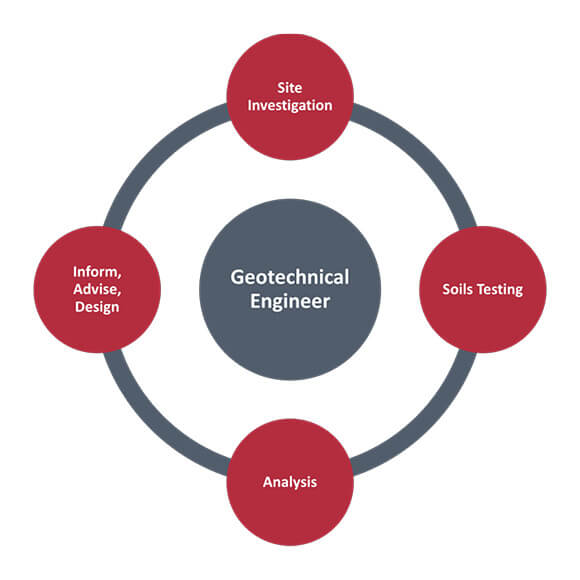Not known Facts About Geotheta
Table of ContentsWhat Does Geotheta Mean?The 20-Second Trick For GeothetaThe Ultimate Guide To GeothetaWhat Does Geotheta Do?Some Known Details About Geotheta

They carry out website examinations, gather examples, do research laboratory tests, and evaluate information to assess the suitability of the ground for building and construction projects - Geo Tech Engineering. Based on their searchings for, geotechnical designers provide referrals for foundation style, incline stability, keeping frameworks, and mitigation of geotechnical threats. They collaborate with other professionals, such as engineers, structural designers, and building groups, to guarantee that geotechnical factors to consider are integrated right into the overall job layout and execution
By analyzing the actions and residential properties of soil and rock, they can identify prospective geotechnical threats such as landslides, soil negotiation, or slope instability. Their expertise aids protect against failures or crashes that could threaten lives and residential property. Below are some thorough duties and duties of a geotechnical designer: Website Examination: Geotechnical engineers conduct site examinations to gather data on subsurface conditions.
They translate the information to understand the residential or commercial properties and habits of the soil and rock, including their toughness, permeability, compaction attributes, and groundwater conditions. Geotechnical Analysis and Layout: Geotechnical designers evaluate the information collected throughout website examinations to analyze the security and viability of the site for building and construction projects. They do geotechnical estimations and modeling to review elements such as birthing capacity, settlement, slope stability, lateral planet pressures, and groundwater flow.
The 45-Second Trick For Geotheta
Structure Layout: Geotechnical designers play a vital role in designing foundations that can securely sustain the intended structure. They evaluate the dirt conditions and tons needs to establish the appropriate structure kind, such as superficial structures (e.g., grounds), deep foundations (e.g (https://www.metal-archives.com/users/geotheta)., heaps), or specialized techniques like dirt enhancement. They take into consideration variables such as negotiation limitations, bearing capacity, and soil-structure communication to establish ideal structure styles
They assess construction plans, monitor site activities, and carry out field inspections to verify that the layout recommendations are complied with. If unexpected geotechnical problems emerge, they evaluate the scenario and offer referrals for removal or adjustments to the style. Risk Assessment and Mitigation: Geotechnical engineers evaluate geotechnical hazards and threats connected with useful source the job site, such as landslides, liquefaction, or soil erosion.

Collaboration and Interaction: Geotechnical designers function closely with various other specialists involved in a job, such as designers, structural engineers, and building teams. Effective interaction and collaboration are vital to integrate geotechnical considerations right into the general task style and building and construction procedure. Geotechnical designers offer technological proficiency, solution questions, and make sure that geotechnical needs are satisfied.
Everything about Geotheta
Here are some kinds of geotechnical engineers: Structure Engineer: Foundation engineers focus on creating and examining structures for structures. They evaluate the soil problems, load needs, and site characteristics to figure out one of the most proper structure type and design, such as shallow foundations, deep foundations, or specialized strategies like stack structures.
They examine the factors affecting incline stability, such as dirt homes, groundwater conditions, and slope geometry, and create methods to avoid incline failings and minimize threats. Earthquake Designer: Earthquake designers specialize in examining and creating frameworks to withstand seismic forces. They analyze the seismic hazard of a website, assess soil liquefaction capacity, and develop seismic layout requirements to make sure the safety and durability of structures during earthquakes.
They do area testing, gather samples, and examine the accumulated information to identify the soil residential or commercial properties, geologic developments, and groundwater conditions at a website. Geotechnical Instrumentation Designer: Geotechnical instrumentation designers concentrate on surveillance and measuring the actions of soil, rock, and frameworks. They set up and maintain instrumentation systems that keep track of aspects such as dirt negotiation, groundwater degrees, incline motions, and architectural displacements to assess efficiency and provide very early warnings of prospective issues.
The 25-Second Trick For Geotheta
They perform tests such as triaxial examinations, combination examinations, direct shear tests, and permeability tests to gather information for geotechnical analysis and design. Geosynthetics Engineer: Geosynthetics designers focus on the design and application of geosynthetic products, such as geotextiles, geogrids, and geomembranes. They use these products to improve dirt security, reinforce inclines, give water drainage solutions, and control disintegration.
They have a tendency to be investigative people, which means they're intellectual, reflective, and curious. They are interested, methodical, reasonable, analytical, and rational. Some of them are additionally social, implying they're kind, generous, participating, individual, caring, handy, understanding, tactful, and pleasant - Geo Tech Engineer.
In the workplace atmosphere, geotechnical engineers use specialized software application tools to execute computations, develop styles, and assess data. They prepare records, testimonial project specs, connect with customers and employee, and coordinate task activities. The workplace setting offers a favorable setting for research study, evaluation, and partnership with various other specialists associated with the task.
The Geotheta Diaries
They regularly go to task websites to carry out site investigations, assess geotechnical problems, and gather data for analysis. These check outs include traveling to different locations, sometimes in remote or tough terrains. Geotechnical designers may carry out dirt tasting, conduct tests, and display construction activities to make certain that the geotechnical aspects of the task are being carried out correctly.
Geotechnical engineers also function in specialized geotechnical labs. Geotechnical lab engineers function thoroughly in these atmospheres, managing testing tools, operating instruments, and tape-recording data.